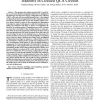98 search results - page 5 / 20 » Messages, Clocks, and Gravitation |
IPSN
2004
Springer
14 years 1 months ago
2004
Springer
Recent advances in technology have made low cost, low power wireless sensors a reality. Clock synchronization is an important service in any distributed system, including sensor n...
TVLSI
2008
13 years 8 months ago
2008
Abstract--The quantum-dot cellular automata (QCA) model offers a novel nano-domain computing architecture by mapping the intended logic onto the lowest energy configuration of a co...
SSS
2009
Springer
14 years 1 months ago
2009
Springer
We present a simple algorithm that implements the Omega failure detector in the crash-recovery model. The algorithm is quiescent, i.e., eventually all the processes but the leader ...
DAC
2008
ACM
2008
ACM
Model checking based analysis of end-to-end latency in embedded, real-time systems with clock drifts
14 years 9 months ago
End-to-end latency of messages is an important design parameter that needs to be within specified bounds for the correct functioning of distributed real-time control systems. In t...
ICDCSW
2002
IEEE
14 years 1 months ago
2002
IEEE
Time-driven Key Sequencing (TKS) is a key management technique that synchronizes the session key used by a set of communicating principals based on time of day. This relatively lo...

